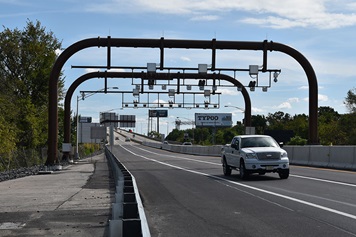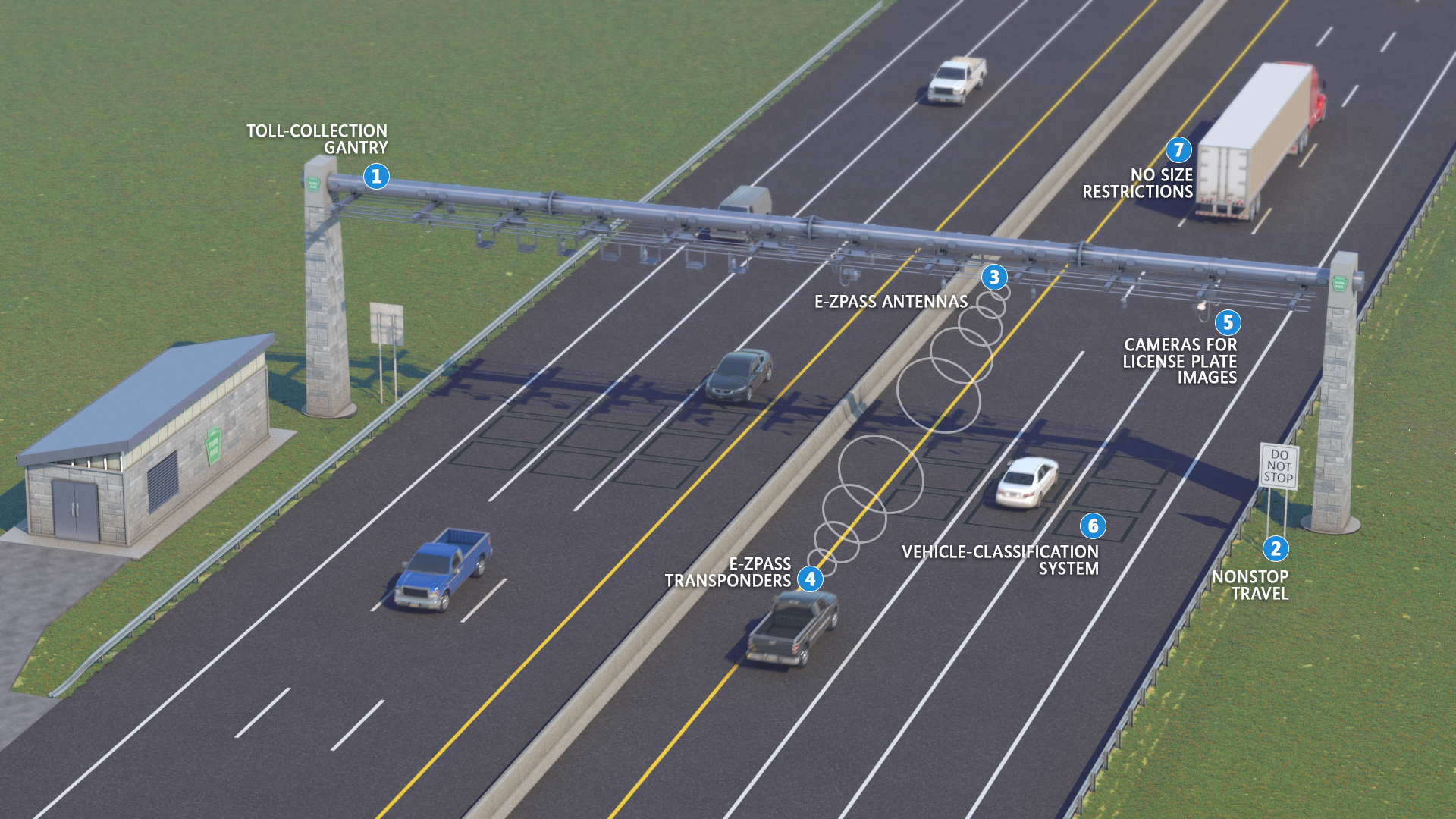
Open Road Tolling Coming to the PA Turnpike
Open Road Tolling is a cashless, free-flowing mode of collecting tolls without traditional toll plazas or tollbooths. In an ORT system, tolls are charged electronically as customers drive at highway speeds without slowing down or stopping beneath overhead structures — called gantries — located between interchanges. Equipment on the gantry and in the roadway classifies and identifies the vehicle and electronically processes tolls. ORT allows free-flowing traffic, which reduces accidents and offers the convenience our customers expect and appreciate.
Travelers along the central or eastern portion of the PA Turnpike may have noticed ORT construction already underway, including small structures built at the roadside to house equipment.
.jpg?sfvrsn=d8414720_1)
The image above shows what the new overhead steel structures, called gantries, look like on the PA Turnpike. Motorists traveling on the eastern part of the PA Turnpike's mainline, and the Northeast Extension, will already see them along the roadway.
Greater Access and Increased Safety
Our customers and industry partners prefer cashless tolling. More than 86% of PA Turnpike travelers use E-ZPass, and 70% of travelers surveyed said they prefer AET to traditional interchanges.
That doesn’t mean those without credit cards, bank accounts, or with cash-payment preferences get left behind. Toll payments can be made using the KUBRA network, available at convenience stores, including Sheetz, Rutters, and 7-11, and numerous retail locations such as Dollar General, Walgreens, and Family Dollar.
ORT increases mobility and efficiency for our customers, allowing more timely and reliable trips across the Commonwealth. This includes those commuting for work, traveling to see family and commercial traffic moving goods and services in support of our national economy.
Eventually, the PA Turnpike will be eliminating toll plazas from the interchanges which may alleviate some common driver anxieties. These changes will increase line of site at the interchange for motorists entering or exiting the system, remove the need for motorists to squeeze into seemingly narrow tollbooth lanes, and the jockey for lane position.
Open Road Tolling also allows the PA Turnpike to build new connections between existing interchanges at a fraction of the cost while providing more communities with direct PA Turnpike access, helping to drive economic growth. These requests for access have historically been virtually impossible to honor due to the significant cost and land needed to construct an interchange. ORT opens that opportunity for the PA Turnpike and communities we pass through.
As traditional tolling structures are removed, the PA Turnpike will work with communities to design spaces that announce, “you’ve arrived.” The initiative, dubbed Gateways, seeks input from civic, recreational, and artisan groups to create installations that highlight outdoor beauty, historic, cultural, educational destinations or note distinctive attractions.
Sustainability
The technology upgrade ORT requires led to significant investment in fiber optics across the entire system. The first sections of the 500-mile network – made of energy efficient, ecologically resilient material – began in 2022.
When complete, it will empower an array of operational improvements, add new funding streams, and support the state’s future needs, including connected/autonomous vehicle technology. Additionally, it will meet the PA Turnpike’s commitment to being a good neighbor by extending broadband connectivity opportunities to underserved areas along the roadway.
ORT’s environmental benefits dovetail with the PA Turnpike’s commitment to designing a sustainable transportation future. As plazas and booths come down, less land will be used to construct new access points; and approximately 100 acres previously covered by concrete will be restored.
With traffic moving at highway speeds, there’s less vehicle idling. Following 2020’s conversion to cashless tolling, there was a 45% systemwide reduction in CO2 emissions, or approximately 65 tons per year. ORT is projected to bring a further 7%, or 11-ton-per-year CO2 reduction.
The image above shows how the data is collected at the gantry then transferred via a broadband fiber optic network for verification, processing and payment.
Customer Driven
The move to ORT has been under way for more than a decade, beginning with a comprehensive study examining technology, and customer impact. In 2016, a series of pilot programs phasing out cash-at-the-plaza payment options began, yielding industry-standard patterns of toll collection reliability.
When the COVID-19 pandemic struck four years later, the PA Turnpike was prepared to seamlessly accelerate its planned move to systemwide All Electronic Tolling (AET), eliminating physical cash collection at interchanges to safeguard operations and maintain customer and employee safety.
Through it all, the PA Turnpike continued to meet expected and consistent levels of toll collection, while posting better-than-average E-ZPass adoption numbers. As a result, the PA Turnpike captures 93-94% of revenues — which in FY23 equates to about $1.6 billion.
Our collection rate is well within industry standard; leakage, or the 6-7% of transactions that don’t realize revenue, has long been a challenge — even during the tollbooth era. However, the PA Turnpike continues, as it did during pilot testing, to meet industry expectations.
The leakage issue is one of customer nonpayment with only 1-2% attributed to bad DMV addresses and plate recognition issues.
Due to the Toll By Plate rate structuring, leakage is not a revenue problem. But, it is an issue of fairness to ensure all drivers pay their share. The PA Turnpike works hard to make paying tolls as easy as possible. Payments are accepted:
- Online
- Over the phone
- In person at the Harrisburg Customer Service Center
- Cash payment network
- Via the Toll by Plate app
It’s also possible to convert a Toll By Plate invoice to an E-ZPass account when making a payment -- which saves money instantly.
And for those who still don’t pay their invoices, the PA Turnpike uses multiple, escalating remedies to compel payment, including late fees, debt collection, vehicle registration suspension, and legal action against egregious violators.
The PA Turnpike worked closely with the PA House and Senate transportation committees and General Assembly leadership to pass a 2023 law that lowered registration suspension thresholds from $500 to $250 in unpaid tolls. Proposed legislation to garnish PA tax return or lottery winnings over $2,500 is under consideration now.
Customers – including commuters, tourists, and trucker drivers – pay to use the Turnpike because it is an efficient road with fewer traffic stops. The customer-driven conversion to ORT will reduce congestion, noise, and travel times while maintaining the PA Turnpike’s commitment to sustainable transportation practices.
By Bradley J. Heigel, P.E., Chief Engineer, Pennsylvania Turnpike Commission


